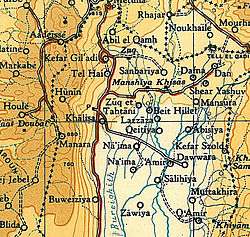Hunin
| Hunin | |
|---|---|
 Hunin | |
| Arabic | هونين |
| Name meaning | from personal name,[1] |
| Subdistrict | Safad |
| Coordinates | 33°12′52″N 35°32′41″E / 33.21444°N 35.54472°ECoordinates: 33°12′52″N 35°32′41″E / 33.21444°N 35.54472°E |
| Palestine grid | 201/291 |
| Population | 1,620 (1945) |
| Area | 14,224 dunams |
| Date of depopulation | 3 May 1948 and September 1948[2] |
| Cause(s) of depopulation | Fear of being caught up in the fighting |
| Secondary cause | Expulsion by Yishuv forces |
| Current localities | Margaliot |
Hunin (Arabic: هونين) was a Palestinian Arab village in the Galilee Panhandle part of Mandatory Palestine close to the Lebanese border. It was the second largest village in the district of Safed, but was depopulated in 1948.[3]
History
The castle named Chastel Neuf or Castellum Novum in Frankish chronicles, Qal'at Hunin in Arabic, and (Horvat) Mezudat Hunin in Modern Hebrew, was built in two phases by the Crusaders during the 12th century, and was rebuilt by Zahir al-Umar in the 17th century.
In 1752, a mosque was constructed in Hunin. The inscription dedication has been tentatively found to be dedicated to the Ja'far al-Sadiq, the sixth Shia Imam.[4][5]
The village was badly damaged in the earthquake in 1837, according to Edward Robinson who visited in 1856.[6] In 1875, Victor Guérin visited.[7]
In 1881, the Palestine Exploration Fund's Survey of Western Palestine described Hunin: "A village, built of stone, joining on to ruined Crusading castle [..], and containing about 100 Moslems. The situation is on a low ridge just before the hills drop down to the east to the Huleh Valley ; the hills round are uncultivated, covered with low- scrub, but in the valleys there is some arable land. Water is obtained from numerous cisterns ; a birket and spring to the south-east."[8][9]
British Mandate era

Hunin was one of the seven Shiite villages, and 17 other villages, that were transferred from the French to the British spheres in 1924 on the basis of the border agreement of 1923.[10]
In the 1931 census of Palestine, the population of Hunin was 1,075, all Muslims, in a total of 233 houses.[11]
In 1945 the population of Hunin (with Hula and Udeisa) was 1620, with a total of 14,224 dunams of land.[12][13] Of this, Arabs used 859 for plantations and irrigated land, 5,987 dunums were allocated to grain farming,[13][14] while 81 dunams were classified as urban land.[13][15]
1948, aftermath
In May 1948, during hostilities between Arab and Israeli forces, Hunin received an evacuation order from Arab authorities, but the departure of all but 400 residents was the result of a Palmach raid.[16] Four village women were raped and murdered by Israeli soldiers during the summer.[16] In August 1948 village notables approached Kibbutz Kfar Giladi, declaring their willingness to be good citizens of Israel.[3][16] Their proposal was conveyed to the Israeli government, where it received enthusiastic support from the Minorities Minister Bechor-Shalom Sheetrit.[3][10] However, most of the residents were expelled in late August and the remainder in early September when the Carmeli Brigade raided the village killing 20 and blowing up 20 buildings including the mosque.[10][16] Most of the villagers took refuge in Shiite villages in Lebanon.[10]
See also
References
- ↑ Palmer, 1881, p. 21
- ↑ Morris, 2004, p. xvi, village #6. Also gives causes of depopulation.
- 1 2 3 Gelber, 2006, p. 222
- ↑ Sharon, 2007, pp. 108-112
- ↑ Sharon, 2013, p. 289
- ↑ Robinson, 1856, pp. 370-371
- ↑ Guérin, 1880, pp. 370-372
- ↑ Conder and Kitchener, 1881, SWP I, p. 87
- ↑ Conder and Kitchener, 1881, SWP I, pp. 123-125
- 1 2 3 4 Asher Kaufman (2006). "Between Palestine and Lebanon: Seven Shi'i Villages as a Case Study of Boundaries, Identities, and Conflict". Middle East Journal. 60 (4): 685–706.
- ↑ Mills, 1932, p. 107
- ↑ Government of Palestine, Department of Statistics. Village Statistics, April, 1945. Quoted in Hadawi, 1970, p. 69
- 1 2 3 Department of Statistics, 1945, p. 9
- ↑ Government of Palestine, Department of Statistics. Village Statistics, April, 1945. Quoted in Hadawi, 1970, p. 119
- ↑ Government of Palestine, Department of Statistics. Village Statistics, April, 1945. Quoted in Hadawi, 1970, p. 169
- 1 2 3 4 Morris, 2004, pp. 249, 447–448
Bibliography
- Conder, Claude Reignier; Kitchener, Herbert H. (1881). The Survey of Western Palestine: Memoirs of the Topography, Orography, Hydrography, and Archaeology. 1. London: Committee of the Palestine Exploration Fund.
- Department of Statistics (1945). Village Statistics, April, 1945. Government of Palestine.
- Gelber, Yoav (2006). Palestine 1948: War, Escape And The Emergence Of The Palestinian Refugee Problem (2 ed.). Sussex Academic Press. ISBN 1-84519-075-0.
- Guérin, Victor (1880). Description Géographique Historique et Archéologique de la Palestine (in French). 3: Galilee, pt. 2. Paris: L'Imprimerie Nationale.
- Hadawi, Sami (1970). Village Statistics of 1945: A Classification of Land and Area ownership in Palestine. Palestine Liberation Organization Research Center.
- Mills, E., ed. (1932). Census of Palestine 1931. Population of Villages, Towns and Administrative Areas. Jerusalem: Government of Palestine.
- Morris, Benny (2004). The Birth of the Palestinian Refugee Problem Revisited. Cambridge University Press. ISBN 978-0-521-00967-6.
- Palmer, E. H. (1881). The Survey of Western Palestine: Arabic and English Name Lists Collected During the Survey by Lieutenants Conder and Kitchener, R. E. Transliterated and Explained by E.H. Palmer. Committee of the Palestine Exploration Fund.
- Robinson, Edward; Smith, Eli (1856). Later Biblical Researches in Palestine and adjacent regions: A Journal of Travels in the year 1852. London: John Murray.
- Sharon, Moshe (1999). Corpus Inscriptionum Arabicarum Palaestinae, B-C. 2. BRILL. ISBN 90-04-11083-6.p. 49
- Sharon, Moshe (2007). Corpus Inscriptionum Arabicarum Palaestinae, Addendum. BRILL. ISBN 978-90-04-15780-4.
- Sharon, Moshe (2013). Corpus Inscriptionum Arabicarum Palaestinae, H-I. 5. BRILL. ISBN 90-04-25097-2.
External links
- Welcome to Hunin
- Survey of Western Palestine, map 2: IAA, Wikimedia commons
- Hunin, from the Khalil Sakakini Cultural Center